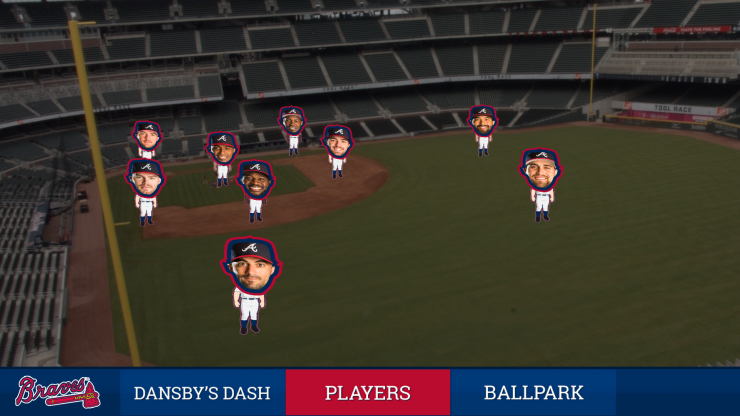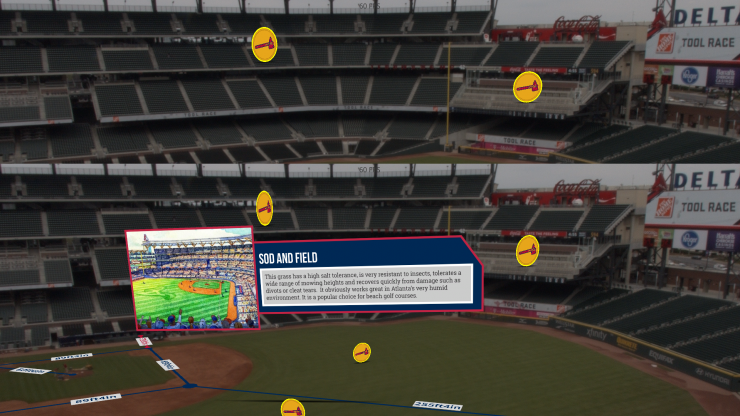For the Fans
Jul 11, 2019 — Atlanta, GA

Using six cameras installed in the catwalks of every NBA arena, SportVU software tracks the movements of every player on the court and the basketball 25 times per second. / YouTube
The field of sports data analytics has been around for 15 years, most notably for capturing and examining player data in baseball. The Oakland Athletics are considered the first professional sports team to use data analytics, as shown in the 2003 book and Academy Award-winning movie Moneyball. With an influx of new and more complex data, statistical tables are no longer as effective. Data visualization, a more recent phenomenon in sports, is a way of clearly and efficiently communicating information through the use of imagery–statistical graphs, plots, and infographs.
Journalists and other communicators have used visualization for years to summarize sports statistics. Coaches and trainers use it, too, for training regimens, understanding injury patterns, and mapping the movement of players on the court and field.
With the growing popularity of fantasy sports leagues, fans are becoming more engaged with player stats and performance and getting in on the data vis action. We're also more visually literate—comfortable digesting bar graphs and scatter plots—according to School of Interactive Computing Associate Professor Rahul Basole.
“People are getting more data savvy and hungry, and the tools have gotten easier across the board,” said Basole. “We are visual creatures. We like to have [data] summarized visually and in an aesthetic and compelling fashion."
Basole also says there’s just simply more data out there on a wide range of sports, ready to be analyzed. He and fellow interactive computing Professor John Stasko are currently examining ShotLink data from the PGA Tour, which tracks every shot from every player across all courses. The organization has made the raw data available to academic researchers for novel analyses.
"Our goal is to visualize ShotLink data to make sense of individual player performance as well as their overall patterns across time and different courses,” said Basole.
He and Stasko plan to visualize the data in an interactive dashboard for a user-oriented perspective. "As with many domains, vis alone is not the sweet spot for sports. It's great for communicating and presenting; it's also great for sensemaking. But it's the combination with analytics that can truly provide insights."
* * *
From USB-enabled cup holders and massive LED scoreboards and displays to the fastest wi-fi at any sporting venue in North America, SunTrust Park is considered one of the most technologically advanced stadiums in the country.
“We view technology as an enabler," said Greg Mize, senior director of marketing & innovation, Atlanta Braves. "One of our sayings is, ‘Don’t pursue and integrate technology for the sake of technology.’" It has to provide value for fans in the form of entertainment, engagement, or information according to Mize. "Our goal is to create the best experience for fans as possible, and technology plays a massive part in that.”
SunTrust Park and the Battery Atlanta are using artificial intelligence to help visitors navigate shops and services, and augmented reality technology to educate visitors about historical artifacts on display at Monument Garden.
Georgia Tech is also partnering with the Atlanta Braves to enhance the fan experience at SunTrust Park. Last season, graduate students studied how long visitors waited in concession lines and how long it took to prepare their food. The Braves then used this research to streamline the process.
Georgia Tech's Interactive Media Technology Center (IMTC) is using augmented reality to give fans an in-depth look at SunTrust Park and Braves players. A high-resolution camera feeds a live view of the entire baseball field to a computer located in the Verizon Lounge. Using a 55-inch touchscreen, lounge visitors can explore the stadium and the live game by interacting with augmented reality (AR) graphics integrated into the camera video feed. Interactive AR graphics include showing the current lineup on the field and individual player statistics. They can also explore SunTrust Park and read little-known facts about the ballpark. Georgia Tech and the Atlanta Braves will launch the augmented reality experience later this spring.
“We’re so lucky to have one of the foremost research and technology universities in Georgia Tech right in our backyard," said Mize. "So it made perfect sense to align with Georgia Tech and form that partnership.”
Scott Robertson, research scientist and IMTC associate director, is envisioning the future of the project. “Right now this is a standalone system so all of the content is static, but the next version could include live information sources,” he said. “One thing we’re interested in doing is, when a player comes up to bat, rendering a transparent heat map on the field which shows where they’re statistically likely to hit the ball.”
Robertson and IMTC researchers are also exploring streaming AR content to mobile devices and installing more cameras for additional views around the ballpark.
* * *
Researchers are also making sports more engaging for a community that venues have historically overlooked: the deaf and hard of hearing.
Captions for Life is a real-time, personal captioning system developed by Leanne West, a principal research scientist at Georgia Tech who has a background in optical physics, and Ethan Adler, a former computer scientist at Georgia Tech. It works by collecting captions on a server in one of three ways—through voice, typing them in real-time, or pre-recorded text. The captions are then sent out via wi-fi or cellular service and displayed on a smartphone screen or on electronic eyewear like Google Glass.
Initially designed for movie theaters, Captions for Life is now meant for use in classrooms, churches, and sports venues. “The idea is that wherever you are at a sports venue, you can get the color commentary to whatever degree they're doing it at the stadium, and it goes with you. You are not tied to a seat or screen,” said West. Using multiple channels, venues can also provide captions in different languages.
West and Adler developed the system in 2000, and the following year received funding from the National Institute on Disability and Rehabilitation Research (NIDRR) through Georgia Tech’s Rehabilitation Engineering Research Center for Wireless Technologies (Wireless RERC). Back then there weren’t many captioning options for the deaf and hard of hearing, but according to West things have changed over the past 15 years. “Now, people are much more aware. Venues are starting to be more proactive, so we think that’s a good sign.”

Atlanta Braves player statistics using augmented reality technology
Alyson Powell Key
Marketing Communications Manager
Institute for People and Technology




